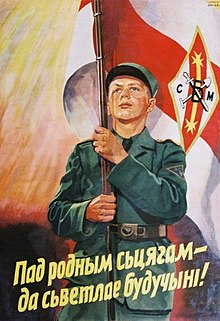Belarusian youth work
The White Ruthenian Youth ( WJW ; Belarusian Саюз беларускай моладзі / Sajuz Belaruskaj moladzi, SBM) was a youth organization during the Second World War in occupied Belarus insisted.
history
The Belarusian Youth Office was founded on June 22, 1943 by order of Commissioner General Wilhelm Kube with the aim of counteracting the labor shortage in Germany. For this purpose, the members of the youth work should be influenced and trained in propaganda, so that these young people themselves act as mouthpieces for German propaganda among their peers and should persuade them to volunteer for work in the Reich .
After the recruitment measures had been very sluggish for the first five months and had only moderate success, the SS and Police Leader (SSPF) for "Belarus" Curt von Gottberg obliged the school directors of the country to "sensitize" the students for entry into the WJW . The teachers were obliged to report the highest possible admission rates for their students. The students were advised to enter through a mix of promises and threats. So it was meant to them that only in this way could they get career and work opportunities. At the end of 1943, young men from the White Ruthenian Youth Office were recruited for the SS and the Wehrmacht . The recruitment of workers took place from the beginning. At the beginning of 1944 the WJW had 8,600 members. By the end of the German occupation, the number increased to around 12,000 members.
With the advance of the Red Army in 1944, the organization was dissolved. While some of the members withdrew to the West, the majority stayed in the country. The success of the recruitment measures up to the time of the dissolution was rather modest. In the spring of 1944, two SS companies made up of members of the youth organization were able to be set up and some volunteers sporadically volunteered for work in the German Reich. But even in the Baranowicze area , the absolute stronghold of recruitment measures, only around one in ten young people could be persuaded to join, and only a fraction of them in other areas. And as a rule, they too tried everything to get a job in Belarus and the hope of being a kind of “insurance against use in forced labor” was associated with membership of the youth welfare organization.
Ideological orientation
The White Ruthenian Youth Office was strongly based on the Hitler Youth . The members should “be brought up in the spirit of Belarusian patriotism”. Michas Ganko was the head of the management staff of the WJW, Nadzeja Abramava was responsible for the work among the girls . Both the girls 'and boys' organizations were divided into three age groups: 10 to 14 year olds, 15 to 18 year olds and 19 to 20 year olds. The accession took place only if the Belarusian origin could be proven. The members received special uniforms: khaki for the boys and blue and white for the girls. From July 1943, the organization published its own magazine "Žyve Belarus" ("Long live Belarus"). At meetings and radio programs, propaganda was spread with the core message of presenting the German occupying power as an advocate of the Belarusian national idea. In addition, the young people were introduced to the Belarusian variant of National Socialism at evening events and training courses . Young activists who were appropriately indoctrinated and used as multipliers of Nazi propaganda towards their peers attended training courses on topics such as “Adolf Hitler - our liberators”, “Jews and Bolsheviks - our enemies”, “What is the New Europe?” Or "What role does National Socialism play in the life of German youth?"
literature
- Alexander Brakel: Under the Red Star and Swastika. Baranowicze 1939 to 1944. Western Belarus under Soviet and German occupation . (= Age of World Wars. Volume 5). Schöningh, Paderborn et al. 2009, ISBN 978-3-506-76784-4 , pp. 214-219.
Individual evidence
- ↑ Alexander Brakel: Under Red Star and Swastika. Baranowicze 1939 to 1944. Western Belarus under Soviet and German occupation Ferdinand Schöningh, Paderborn 2009, p. 214.
- ↑ Alexander Brakel: Under Red Star and Swastika. Baranowicze 1939 to 1944. Western Belarus under Soviet and German occupation . Ferdinand Schöningh, Paderborn 2009, p. 216.
- ↑ Alexander Brakel: Under Red Star and Swastika. Baranowicze 1939 to 1944. Western Belarus under Soviet and German occupation . Ferdinand Schöningh, Paderborn 2009, p. 217.
- ↑ Alexander Brakel: Under Red Star and Swastika. Baranowicze 1939 to 1944. Western Belarus under Soviet and German occupation Ferdinand Schöningh, Paderborn 2009, p. 153.
- ↑ Alexander Brakel: Under Red Star and Swastika. Baranowicze 1939 to 1944. Western Belarus under Soviet and German occupation . Ferdinand Schöningh, Paderborn 2009, p. 217.
- ↑ Alexander Brakel: Under Red Star and Swastika. Baranowicze 1939 to 1944. Western Belarus under Soviet and German occupation . Ferdinand Schöningh, Paderborn 2009, p. 218.
- ↑ Саюз Беларускай Моладзі, slounik.org (Belarusian)
- ↑ Alexander Brakel: Under Red Star and Swastika. Baranowicze 1939 to 1944. Western Belarus under Soviet and German occupation (= Age of World Wars , Volume 5). Schöningh, Paderborn 2009, p. 216, ISBN 978-3-506-76784-4 .

